Emotional storytelling in promotional materials for drama films is a strategic approach that utilizes narrative techniques to evoke feelings and engage audiences. This article explores how emotional storytelling enhances promotional effectiveness by fostering empathy and connection through relatable characters, poignant themes, and evocative visuals. Key elements such as character development, narrative structure, and color psychology are examined, alongside the impact of emotional engagement on audience retention and decision-making. Additionally, the article discusses best practices for filmmakers, including the importance of authenticity and avoiding common pitfalls in emotional narratives.

What is Emotional Storytelling in Promotional Materials for Drama Films?
Emotional storytelling in promotional materials for drama films is the strategic use of narrative techniques that evoke feelings to engage the audience. This approach often incorporates relatable characters, poignant situations, and compelling visuals to create an emotional connection, ultimately driving interest and anticipation for the film. Research indicates that emotional engagement can significantly enhance audience recall and influence their decision to watch a film, as demonstrated by studies showing that emotionally charged trailers lead to higher viewer engagement metrics compared to standard promotional content.
How does emotional storytelling enhance promotional materials?
Emotional storytelling enhances promotional materials by creating a deeper connection between the audience and the content. This connection fosters empathy and engagement, making the promotional material more memorable and impactful. Research indicates that narratives that evoke emotions can increase information retention by up to 65%, as emotional responses activate areas of the brain associated with memory. By incorporating relatable characters and compelling plots, promotional materials can effectively resonate with viewers, driving interest and encouraging action, such as ticket purchases for drama films.
What elements contribute to effective emotional storytelling?
Effective emotional storytelling is primarily driven by character development, relatable themes, and evocative imagery. Character development allows audiences to form connections with protagonists, making their emotional journeys impactful. Relatable themes, such as love, loss, or redemption, resonate with viewers, fostering empathy and engagement. Evocative imagery enhances the emotional experience by creating vivid mental pictures that amplify the narrative’s emotional weight. Research indicates that stories with well-developed characters and universal themes are more likely to elicit emotional responses, as demonstrated in studies by the University of California, which found that emotional engagement significantly increases audience retention and connection to the story.
How do emotions influence audience engagement in promotional content?
Emotions significantly influence audience engagement in promotional content by enhancing relatability and connection. When promotional materials evoke emotions such as joy, sadness, or nostalgia, they create a deeper bond between the audience and the content, leading to increased attention and retention. Research indicates that emotionally charged content is more likely to be shared and remembered; for instance, a study published in the Journal of Advertising Research found that ads eliciting strong emotional responses can increase viewer engagement by up to 23%. This demonstrates that emotional storytelling in promotional materials for drama films can effectively capture audience interest and foster a lasting impact.
Why is emotional storytelling important for drama films?
Emotional storytelling is crucial for drama films because it fosters deep connections between the audience and the characters. This connection enhances viewer engagement, making the narrative more impactful and memorable. Research indicates that films with strong emotional arcs can increase audience retention and satisfaction, as evidenced by a study published in the Journal of Media Psychology, which found that emotionally resonant stories lead to higher viewer empathy and investment in the characters’ journeys. Thus, emotional storytelling not only enriches the viewing experience but also drives the overall success of drama films.
What role does emotional connection play in film marketing?
Emotional connection is crucial in film marketing as it drives audience engagement and influences their decision to watch a film. By tapping into viewers’ emotions, marketers can create compelling narratives that resonate with potential audiences, making the film more relatable and memorable. Research indicates that emotionally charged content can increase viewer retention and sharing rates, with studies showing that ads eliciting strong emotional responses can lead to a 23% increase in sales compared to those that do not. This demonstrates that emotional storytelling in promotional materials effectively enhances the film’s appeal and marketability.
How can emotional storytelling differentiate a drama film from others?
Emotional storytelling differentiates a drama film from others by creating deep connections between characters and audiences, eliciting empathy and engagement. This connection is achieved through relatable characters, compelling narratives, and authentic emotional arcs that resonate with viewers’ experiences. For instance, films like “The Pursuit of Happyness” effectively utilize emotional storytelling by portraying the struggles of a father, which allows audiences to empathize with his journey. Research indicates that emotional engagement significantly enhances viewer retention and satisfaction, making drama films more impactful compared to other genres that may prioritize action or spectacle over emotional depth.

What techniques are used in emotional storytelling for promotional materials?
Emotional storytelling in promotional materials employs techniques such as character development, relatable narratives, and evocative visuals. Character development allows audiences to connect with protagonists, fostering empathy and investment in their journeys. Relatable narratives often reflect universal themes like love, loss, or triumph, making the story accessible and engaging. Evocative visuals, including powerful imagery and soundtracks, enhance emotional resonance, creating a memorable experience. Research indicates that emotionally charged content can increase viewer engagement by up to 70%, demonstrating the effectiveness of these techniques in capturing audience attention and driving promotional success.
How can visuals enhance emotional storytelling in promotions?
Visuals enhance emotional storytelling in promotions by creating immediate emotional connections and conveying complex narratives quickly. For instance, studies show that images can evoke emotions more effectively than text alone, with research indicating that visuals can increase engagement by up to 94%. This is particularly relevant in drama film promotions, where visuals such as character expressions, color palettes, and cinematography can evoke feelings of empathy and anticipation, drawing the audience into the story. By utilizing compelling visuals, promotions can effectively communicate the emotional depth of the film, making the narrative more relatable and impactful for potential viewers.
What types of imagery evoke strong emotions in viewers?
Imagery that evokes strong emotions in viewers includes visual representations of human suffering, joy, and connection. For instance, images depicting intense facial expressions, such as tears or laughter, can trigger empathy and resonate deeply with audiences. Research indicates that visuals portraying personal stories or relatable experiences, such as family reunions or moments of loss, significantly enhance emotional engagement. A study by Paul Ekman on facial expressions highlights that specific emotional cues can elicit corresponding feelings in viewers, reinforcing the effectiveness of such imagery in storytelling.
How does color psychology impact emotional responses in promotional materials?
Color psychology significantly influences emotional responses in promotional materials by evoking specific feelings and associations through color choices. For instance, warm colors like red and orange can stimulate excitement and urgency, while cool colors like blue and green often promote calmness and trust. Research indicates that 85% of consumers make purchasing decisions based on color, highlighting its critical role in marketing. Additionally, a study by the Institute for Color Research found that color increases brand recognition by up to 80%, further demonstrating how effectively color can shape emotional engagement and consumer behavior in promotional contexts.
What narrative structures are effective in emotional storytelling?
Effective narrative structures in emotional storytelling include the three-act structure, nonlinear narratives, and character-driven arcs. The three-act structure, which divides a story into setup, confrontation, and resolution, allows for a clear emotional progression that resonates with audiences. Nonlinear narratives, such as flashbacks or parallel timelines, create suspense and deepen emotional impact by revealing character backstories at pivotal moments. Character-driven arcs focus on the internal growth and transformation of characters, fostering empathy and connection with the audience. Research indicates that stories employing these structures can enhance emotional engagement, as evidenced by studies showing that well-structured narratives lead to higher audience retention and emotional responses.
How can a three-act structure be applied to promotional storytelling?
A three-act structure can be applied to promotional storytelling by organizing the narrative into setup, confrontation, and resolution. In the setup, the promotional material introduces the main characters and the emotional stakes, capturing the audience’s attention and establishing a connection. The confrontation presents the central conflict or challenge faced by the characters, heightening tension and engaging viewers emotionally. Finally, the resolution showcases the outcome, often highlighting the film’s themes and encouraging the audience to seek a resolution by watching the film. This structured approach effectively draws viewers in and enhances their emotional investment, as evidenced by successful campaigns for films like “The Pursuit of Happyness,” which utilized this structure to resonate with audiences and drive ticket sales.
What are the benefits of using character-driven narratives in promotions?
Character-driven narratives in promotions enhance audience engagement and emotional connection. By focusing on relatable characters, promotions can evoke empathy and foster a deeper understanding of the film’s themes. Research indicates that emotional storytelling increases viewer retention and brand loyalty; for instance, a study by the University of Southern California found that narratives featuring strong character development lead to a 30% increase in audience recall compared to traditional promotional methods. This connection not only drives interest in the film but also encourages sharing and discussion among potential viewers, amplifying the promotional reach.

How can filmmakers measure the effectiveness of emotional storytelling in promotions?
Filmmakers can measure the effectiveness of emotional storytelling in promotions through audience engagement metrics, such as viewer retention rates, social media shares, and emotional response surveys. These metrics provide quantifiable data on how well the emotional narrative resonates with the audience. For instance, a study by the University of Southern California found that emotional engagement significantly correlates with viewer retention, indicating that promotions that evoke strong emotions are more likely to keep viewers interested. Additionally, analyzing comments and feedback on social media platforms can reveal audience sentiments and emotional reactions, further validating the impact of emotional storytelling in promotional materials.
What metrics can be used to evaluate audience response?
Metrics that can be used to evaluate audience response include engagement rate, sentiment analysis, and conversion rate. Engagement rate measures interactions such as likes, shares, and comments on promotional materials, indicating how well the content resonates with the audience. Sentiment analysis assesses the emotional tone of audience feedback, providing insights into how viewers feel about the storytelling elements. Conversion rate tracks the percentage of viewers who take a desired action, such as purchasing tickets or sharing the content, reflecting the effectiveness of the promotional strategy. These metrics collectively offer a comprehensive view of audience response to emotional storytelling in drama film promotions.
How can social media engagement indicate the success of emotional storytelling?
Social media engagement serves as a key indicator of the success of emotional storytelling by measuring audience reactions and interactions with content. High levels of likes, shares, comments, and overall engagement metrics suggest that the emotional narrative resonates with viewers, prompting them to connect, reflect, and respond. For instance, a study by the Pew Research Center found that emotionally charged content tends to generate more shares and comments, indicating a deeper connection with the audience. This correlation between engagement and emotional impact highlights the effectiveness of storytelling in promotional materials for drama films, as successful narratives evoke strong emotional responses that drive audience participation on social media platforms.
What role do surveys and feedback play in assessing promotional effectiveness?
Surveys and feedback are critical in assessing promotional effectiveness as they provide direct insights into audience perceptions and engagement levels. By collecting data on viewer reactions, preferences, and emotional responses to promotional materials, marketers can evaluate how well their campaigns resonate with the target audience. For instance, a study by the American Marketing Association found that 70% of marketers who utilized surveys reported improved campaign performance due to actionable insights gained from audience feedback. This data-driven approach enables adjustments to promotional strategies, ensuring they align with audience expectations and enhance overall effectiveness.
What best practices should filmmakers follow when utilizing emotional storytelling?
Filmmakers should prioritize character development and authenticity when utilizing emotional storytelling. Strong character arcs allow audiences to connect deeply with the narrative, fostering empathy and emotional investment. For instance, a study by the University of Southern California found that viewers are more likely to engage with films that feature relatable characters facing genuine emotional challenges. Additionally, employing visual and auditory elements, such as music and cinematography, enhances the emotional impact of the story. Research from the Journal of Media Psychology indicates that specific musical cues can evoke particular emotions, reinforcing the narrative’s emotional tone. By focusing on these best practices, filmmakers can create compelling emotional experiences that resonate with their audience.
How can filmmakers ensure authenticity in their emotional narratives?
Filmmakers can ensure authenticity in their emotional narratives by deeply researching and understanding the lived experiences of the characters they portray. This involves engaging with real-life stories, consulting experts, and incorporating genuine emotional responses that resonate with audiences. For instance, films like “The Pursuit of Happyness” drew from the true story of Chris Gardner, which added layers of authenticity to the emotional journey depicted. By grounding narratives in real experiences and emotions, filmmakers can create relatable and impactful stories that reflect true human conditions.
What common pitfalls should be avoided in emotional storytelling for promotions?
Common pitfalls to avoid in emotional storytelling for promotions include over-sentimentality, lack of authenticity, and failure to connect with the target audience. Over-sentimentality can alienate viewers, as excessive emotional manipulation may come off as insincere. Authenticity is crucial; if the story does not resonate with the brand’s values or the audience’s experiences, it can lead to distrust. Additionally, failing to understand the target audience’s emotional triggers can result in a disconnect, making the promotional material ineffective. Research indicates that emotionally resonant stories that align with audience values are more likely to drive engagement and conversion, highlighting the importance of these considerations in promotional storytelling.
